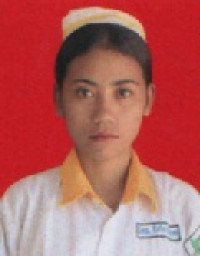Detalhe do registro
BUSKA AVANSADU
Faculdade de CiĂȘncias da SaĂșde
DESKRISAUN KOĂESEMENTU HO HAHALOK FAMILIA KONABA PREVENSAUN MORAS INFEKSAUN RESPIRATORIO AGUDU (IRA) BA LABARIK HO TINAN 5 MAI KARAIK IHA HOSPITAL REFERAL SUAI MUNISIPIU COVALIMA TIMOR-LESTE TINAN 2024
ABSTRATU
DESKRISAUN KONESEMENTU HO HAHALOK FAMILIA KONABA
PREVENSAUN MORAS INFEKSAUN RESPIRATORIO AGUDU
(IRA) BA LABARIK HO TINAN 5 MAI KARAIK IHA
HOSPITAL REFERAL SUAI MUNISIPIO
COVALIMA TIMOR-LESTE
TINAN 2024.
UNIVERSIDADE ORIENTAL TIMOR LOROSAâE (UNITAL)
Antesendente: Infeksaun respiratorio agudu (IRA) hanesan problema
publiku ida ne'ebe impaktu jeral ba morbilidade no mortalidade moras
infeksaun iha mundu. Kauza ema mate hamutuk tokon 400 tamba
infeksaun respiratorio. Kazu IRA iha Indonesia iha tinan tolu liu ba nia hola
primeiru ba mortalidade ba bebe ho prosentu 32,1% (2017) 18,2% (2010)
no 38,8% (2019) familia sai hanesan ema ne'ebe besik liu ba nia oan sira.
Infeksaun respiratorio aguda (IRA) sai hanesan problema saude ne'ebe
mak inportante tanba bele kauza primeiru ba kazu mortalidade ne'ebe
mak akontese ba labarik sira iha nasaun dezenvolvidu. No iha tinan 2019
hahu husi fulan janeiru to'o dezembru total husi labarik 2176 kompostu
husi mane 1124 labarik no ba feto 1052 labarik no iha tinan 2020 hahu iha
fulan janeiru to'o setembru ho total 1563 labarik no ba mane 767 no feto
796 labarik .(SSK 2020).
Objetivu: Atu hatene kona ba Oinsa Deskrisaun konesementu ho hahalok
familia konaba Prevensaun moras infeksaun respiratorio agudu (IRA) ba
labarik ho tinan 5 mai karaik. Objetivu Espesifiku 1. Atu identifikas
konesementu familia nian kona ba Prevensaun moras infeksaun
respiratorio agudu (IRA) 2. Atu identifika hahalok familia kona ba
Prevensaun moras infeksaun respiratorio agudu (IRA) ba labarik ho tinan
5 mai
Metodolojia Peskiza: Metodu deskritivu neâe metodu ida konaba estuda
peskiza neâebe estuda peskiza neâebe uja atu esplika dezenu problema
sira neâebe akontese iha tempu agora no tuir mai, ho objetivu atu proposta
deâit mak akontese bainhira atu halaâo peskiza neâe (Sudjana 2010).
Resultadu Peskiza : Rejultadu hatudu katak husi respondente nain 37
maioria ho idade tinan 19-29 total hamutuk ema nain 14 ho persentazen
(38%). No minoridade ho idade 30-40 total hamutuk ema nain 16 pursentu
( 43%) no menus liu mak idade 41-45 hamutuk ema nain 7 ho nia
porsentu (19%).
Konkluzaun : Bazeia ba resjultadu peskiza no esplikasaun neâebe iha ona
kapitulu antes neâe sei halo rezumu iha konkluzaun balun tuir mai neâe:
Konesementu respondente Maioria naton hamutuk nain 21 ho
Respondente hamutuk (57%). Hahalok respondente neâebe Maioria la
diak hamutuk 16 ho respondente hamutuk (43%)
Lia Fuan Save : Koñesementu Atitude Moras Infeksaun Respiratorio
Agudu (IRA) Ba Labarik
ABSTRACT
DESCRIPTION OF FAMILY KNOWLEDGE ABOUT PREVENTION OF
ACUTE RESPIRATORY INFECTION (IRAN) FOR CHILDREN
AGED 5 YEARS MAY HAVE REFERRAL HOSPITAL
IN THE MUNICIPALITY COVALIMA
TIMOR LESTE 2024.
UNIVERSITY ORIENTAL TIMOR LOROSAâE (UNITAL)
Intoduction: acute respiratory infection (IRA) is a public problem that has
a general impact on the mobility and mortality of infectious diseases in the
world. Causes a total of 400 million deaths due to respiratory infections.
IRA cases in Indonesia in the past three years were first taken for the
mortality rate of 32,1% (2017) 18,2% (2010) and 38,8% (2019) families
were the first to be close to their children. Acute respiratory infection (IRA)
is an important health problem because it can cause the first cause of
mortality that occurs in children in developing countries. In 2019 from
January to December the total number of 2176 children was 1124 children
and 1052 children and in 2020 it began in January to September with a
total of 1563 children and 767 men and 796 women. (ssk 2020).
Objective: To find out how to describe family behaviour in preventing
acute respiratory infections (IRA) in children aged 5 years. Specific
Purpose 1. To identify family knowledge about prevention of acute
respiratory infection (IRA) 2. To identify family behaviour on Prevention of
acute respiratory infection (IRA) in children aged 5 years
Research methodology: The descriptive method is a research study
method that studies research that is used to explain the design of
problems that occur at present and later, with the aim of a proposal that
occurs when conducting the research (Sudjana 2010).
Research findings: The results show that the majority of 37 respondents
aged 19 - 29 years were 14 with a percentage (38%). And the total
minority aged 30 - 40 is 16 per cent (43%) and the lowest is 41 - 45 per
cent (19%).
Conclusion: Based on the findings of the research and explanation in the
previous chapter, a summary of the following conclusions will be made:
Knowledge of the majority of the respondents was 21 with the respondents
(57%). The majority of the respondents did not have 16 respondents
(43%)
Word of Word: Knowledge of the attitude of respiratory infections
Acute (IRA) For Children.
Disponibilidade
| FSAU5617 | 200701079 | 228 | DisponĂvel |
Detail Information
| TĂtulo da sĂ©rie |
-
|
|---|---|
| NĂșmero de chamada |
200701079
|
| Editora | UNITAL : DILI., 2024 |
| Paginação |
xviii ; 43 pag
|
| Idioma |
Tetun
|
| ISBN/ISSN |
200701079
|
| Classificação |
NONE
|
| Content Type |
-
|
| Media Type |
-
|
|---|---|
| Carrier Type |
-
|
| Edição |
2024
|
| Assunto(s) | |
| Detalhe especĂfico |
-
|
| Statement of Responsibility |
ZENITA EDUARDA GUSMĂO
|
Other version/related
No other version available







